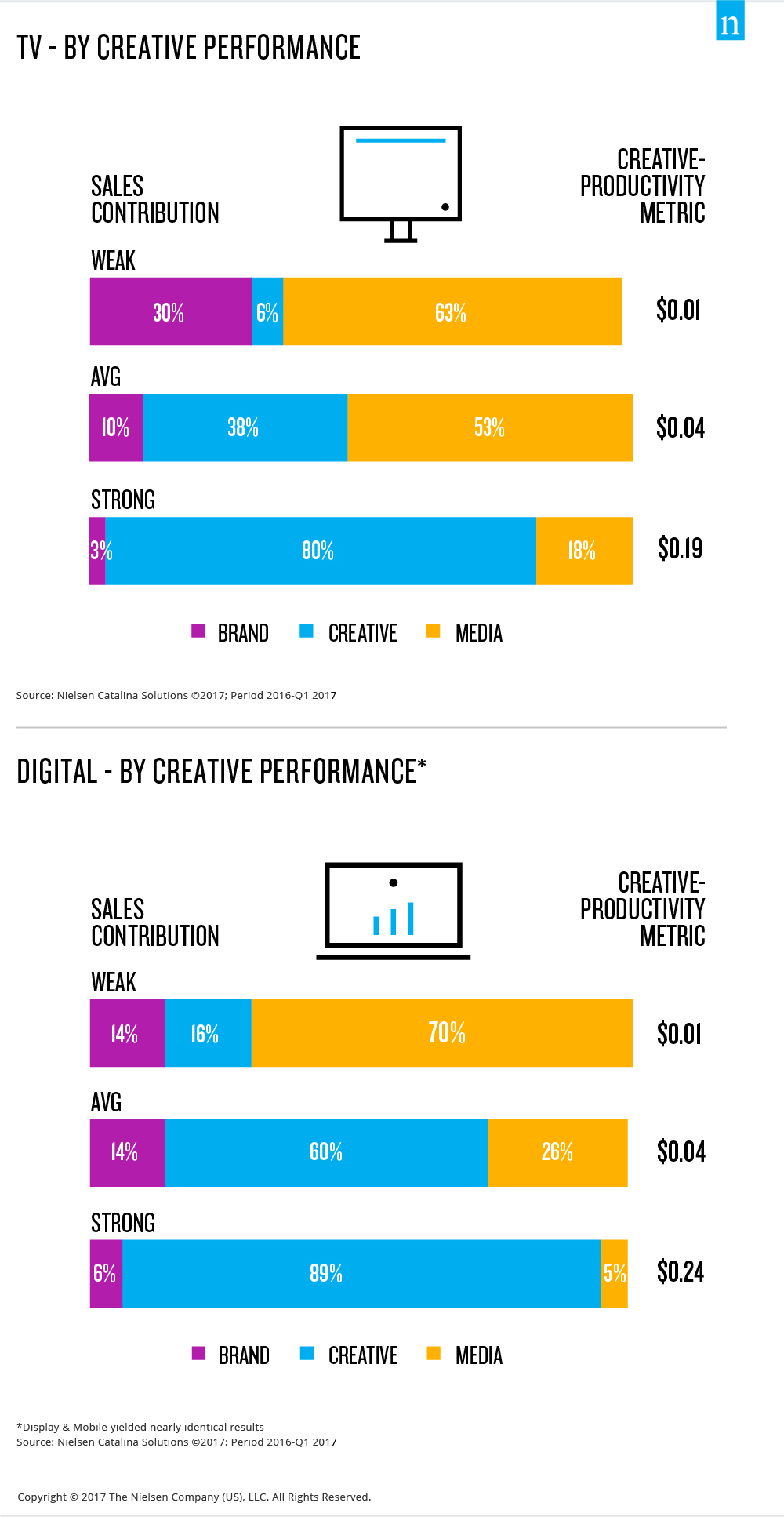 최근 어느 날 아침, 사무실에서 무엇이 훌륭한 광고인지에 대한 즉흥적인 토론이 벌어졌습니다. 우리는 최근 가장 마음에 들었던 몇 가지 광고에 대해 논의했고, 예상대로 어떤 광고가 가장 좋았는지에 대한 다양한 의견이 제시되었습니다. 짧은 형식과 긴 형식. 재미있고 감성적인 광고. 제품 중심 및 브랜드 중심. 이성적이고 감성적인 광고. 광고의 길이와 목적이 다양했지만 한 가지 분명한 점은 프로그램 휴식 시간 사이에 끼워 넣는 광고가 아니라 계속해서 이야기하고, 공유하고, 보고 싶은 '꼭 봐야 할' 광고라는 점입니다.
최근 어느 날 아침, 사무실에서 무엇이 훌륭한 광고인지에 대한 즉흥적인 토론이 벌어졌습니다. 우리는 최근 가장 마음에 들었던 몇 가지 광고에 대해 논의했고, 예상대로 어떤 광고가 가장 좋았는지에 대한 다양한 의견이 제시되었습니다. 짧은 형식과 긴 형식. 재미있고 감성적인 광고. 제품 중심 및 브랜드 중심. 이성적이고 감성적인 광고. 광고의 길이와 목적이 다양했지만 한 가지 분명한 점은 프로그램 휴식 시간 사이에 끼워 넣는 광고가 아니라 계속해서 이야기하고, 공유하고, 보고 싶은 '꼭 봐야 할' 광고라는 점입니다.
저는 닐슨 카탈리나 솔루션(NCS)과 닐슨이 공동으로 진행한 새로운 연구 프로젝트의 결과를 검토하면서 훌륭한 크리에이티브의 중요성을 다시 한 번 깨달았습니다. 그 결과는 광고에 대한 오래된 진리, 즉 크리에이티브가 왕이라는 사실을 다시 한 번 확인시켜 주었습니다. 크리에이티브는 우리가 참여하고, 공유하고, 이야기하고, 토론하고, 기억하고, 구매하는 것을 이끄는 원동력입니다. 크리에이티브는 언제, 어디서, 어떻게 실행되든 큰 힘을 발휘합니다. 1984년 Apple이 매킨토시 컴퓨터를 소개하는 광고는 지금도 가장 많이 회자되는 광고 중 하나이며, 전국 TV를 통해 단 한 번도 방영된 적이 없습니다.
이 연구는 광고 효과에 기여하는 5가지 주요 요인인 크리에이티브, 도달 범위, 타겟팅, 최신성 및 컨텍스트의 매출 기여도를 정량화하고자 했습니다. 연구 결과는 시간이 지남에 따라 이러한 동인 간의 상대적 균형이 어떻게 변화했는지, 그리고 TV와 디지털 채널에서 어떻게 작용하는지 보여줍니다. 가장 흥미로운 점은 크리에이티브 품질이 다른 모든 요소를 합친 것만큼이나 브랜드의 시장 내 성공에 기여한다는 결과가 나왔다는 점입니다. 이 연구에 따르면 크리에이티브가 강할 때 시장 내 성공의 압도적인 원동력은 기존 TV 광고의 경우 최대 80%, 디지털 광고의 경우 89%에 달했습니다. 반대로 크리에이티브가 약할 때는 TV와 디지털 모두에서 매출 상승 효과가 약하고 다른 미디어 요인이 주요 동인으로 작용했습니다.
한마디로 훌륭한 크리에이티브는 전통적인 TV와 디지털 플랫폼 모두에서 광고 캠페인의 성공에 있어 가장 중요한 요소입니다. 새로운 도구와 기법을 통해 타겟 도달 범위를 향상시키고 확장할 수 있으며, 광고주가 소비자를 찾는 데 도움이 되는 새로운 형식과 대상도 매일 새롭게 등장하고 있습니다. 하지만 진정으로 성공적인 광고 캠페인을 이끌어내는 데 있어서는 훌륭한 크리에이티브가 제공하는 힘을 따라올 수 없습니다.

This, of course, raises several questions: What is great creative? How do marketers know if their creative is “great?” And how do they achieve great success with it?
In the past, marketers have relied on qualitative and/or quantitative self-report copy testing to evaluate creative. Essentially, they made decisions based on biased consumer responses often aided by their professional eyes and instincts. Essentially, they went with what they thought would work. While this may have kept very poor advertising off the air, it left some potentially great work on the drawing board. And if they had a piece of creative they needed to cut down/compress, they might have relied on personal judgment.
This is where consumer neuroscience increasingly plays an important role for marketers. That’s because the current suite of tools combining EEG, eye tracking, facial coding and biometrics, along with self-report surveys, offer a unique opportunity. Not only can these tools measure and evaluate on a macro level (i.e., what works and what doesn’t), they go even deeper, providing moment-by-moment insight that can pinpoint where a spot(s) needs to be adjusted. The results enable a collaborative approach between marketers, creative agencies and researchers to help go from early stage to primetime success—avoiding the cutting-room floor that has claimed too many could-have-been-great ads. This is because consumer neuroscience measures what traditional research methods cannot. Methods like surveys can only tap into our conscious responses, which we know are often heavily biased and are only one, arguably smaller, component of how we consume media. Studies have shown that the majority of our decision-making happens non-consciously, so much of what drives everyday decisions—including what we’ll purchase, watch and talk about—requires tools that can measure these responses.
Several years ago, we developed a model designed to understand the explosion in content platforms and the types of creative that can be optimized for each. Our Brand Immersion Model became a framework for defining the relationship between the immersive platform of TV and digital’s flexible platforms. Our research found that TV, through its unmatched ability to create new, unconscious emotional connections, has the power to form need states—which make consumers receptive to brand messages—where none existed before. Flexible environments play a key role in reinforcing need states. So the two work together in powerful, synergistic ways.
It’s important to understand this relationship in order to develop creative that will be great on each platform. The Brand Immersion Model breaks down the two primary ways to engage with content:
Highly Immersive Platforms: Viewers are more apt to be passive participants, observing content that substitutes the viewers’ emotional state with the emotional lives of the onscreen characters. If those characters need a product, the viewer feels that same need. Examples include television, virtual reality, theaters and home theaters, IMAX and events like the Olympics. Immersive content enables us to experience others and generate need states that previously did not exist.
Highly Flexible Platforms: Viewers are more apt to be active participants, constantly searching for something that engages them. This content requires the need to already become established. The content or advertising then supports this need. Examples include smartphones and tablets with email, social media and the websites that provide a never-ending search for more. Flexible content enables us to develop our own experience and satisfy need states that already exist.
Television is highly effective as an advertising platform because it is the primary medium that can create a need state, either through experiencing the needs of the onscreen characters during the primary content or through the high emotional involvement with on-screen characters during the advertising itself.
With flexible experiences, individuals seek out an experience more customized to their interests. For the most successful executions, this can result in higher engagement with content than on an immersive platform because it’s tailored to what the consumer is seeking. The reason for this heightened engagement is that the content is user-generated—people seek to broaden their conversations with each other and trusted sources like influencers instead of with the stories of new characters in an advertisement. Unless the ad is for a product the consumer already knows that he or she wants at that moment and it takes up enough of the screen to get noticed without turning the viewer “off,” it cannot generate the same level of connection.
So how do you ensure that your creative and different platforms go hand-in-hand for the most optimal engagement? How can we move from must-skip to must-watch? And how do we turn turn-out into tune-in? It’s simple: tap into the full spectrum of consumers’ responses— both conscious and non-conscious—to uncover areas of emotional impact, visual hot spots, blind spots and inform the strongest possible creative development.


